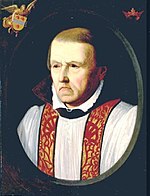Prince's Court (Delft)
The Prinzenhof in Delft is a museum that is located in a former monastery. The building complex got its name from Wilhelm von Oranien , who resided here from 1572 until his murder in 1584.
Sint Agathaklooster
Around 1380 several women gathered around the priest Jacob Jan who wanted to dedicate their lives to God. At first they lived in great poverty, which changed when the wealthy widow Alijd Buser joined the sisters and became their first matron. Under her leadership, the steadily growing community of sisters, who made their living by spinning and weaving, was officially elevated to Sint Agathaklooster in 1404 . The monastery complex came to the Tertiarissen through a foundation , which subsequently more and more women of distinguished origin joined. The women gave their property to the monastery, so that its wealth and size increased steadily. It therefore also functioned as adequate accommodation for high-ranking guests of the city of Delft.
From the beginning of the 16th century, the clashes between the Calvinist Dutch and the Catholic Spanish who ruled the provinces increased in violence. The monastery survived the iconoclasm of 1566 undamaged, but in 1572 its last rector Cornelis Musius was executed in Leiden . In the same year the monastery was confiscated by the Staten van Holland and handed over to their leader William of Orange, as he needed a safe place to live for himself and his family. The remaining nuns were allowed to stay; they were housed in the south wing, now the Nusantara Museum. The last nun died in 1640.
Residence of the governor
Except for the southern wing and the chapel (later Waalse Kerk), the building complex was prepared for the leader of the rebels and his entourage. Since Wilhelm came to the Principality of Orange through an inheritance , he bore the title of Prince, so that the new residence was called the Prinzenhof. His living room and bedroom were on the first floor on the corner with Oude Delft; from there he could see the Oude Kerk .
Two of his children were born here, most recently by his fourth wife Louise de Coligny, the future governor Friedrich Heinrich . Six months later, in July 1584, William of Orange was assassinated on the staircase built for him . The traces of the murder, bullet holes on the wall of the stairwell, can still be seen. After his death, the building complex was used by the governor's family for some time.
Further use
The city administration of Delft used the buildings of the prince's court as late as the 17th century at times as packing and clothing houses and for the tannery . The dining room initially served as a reception and festival hall; In the 18th century the Delft Collegium Musicum also practiced here. In 1776 the Latin school was opened in the Prinzenhof. But from 1795 the school often had to move rooms because the military demanded more and more space for its purposes. In 1807 the Latin school left the Prinzenhof; the complex had now completely become a barracks .
museum
Slowly the awareness of the historical importance of the Prinzenhof grew. On the 300th anniversary of the death of William of Orange, an exhibition was shown in the historical hall - the so-called murder hall - and the dining room. As a result, both rooms were restored and opened to the public in 1887 as the Rijksmuseum 'De Historische Zaal van het Prinsenhof'. The chapter house was connected to this in 1894 and the floor above the historical hall in 1899. In 1906 the collection of the Delft Municipal Museum, founded in 1897, was also housed here. The military, however, gradually withdrew completely by 1925. Since then, the building complex has retained its function as the Stedelijk Museum Het Prinsenhof . After a fundamental renovation, it was reopened under the name Museum Prinsenhof Delft in May 2014 by King Willem-Alexander . Since then, in addition to collections on the subjects of William of Orange and the founding of the republic, it has also shown works of art from the 16th and 17th centuries ( Meesters in innovatie ) as well as numerous Delft blue faiences . There are also regularly changing exhibitions.
Web links
- Museum website (Dutch, English)
- Museumgids Willem van Oranje 2013
- Monument number: 12029 Rijksdienst voor het Cultureel Erfgoed (Dutch)


